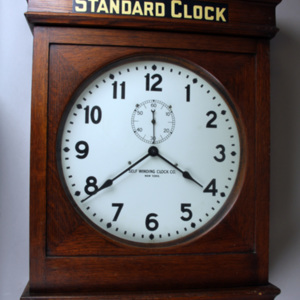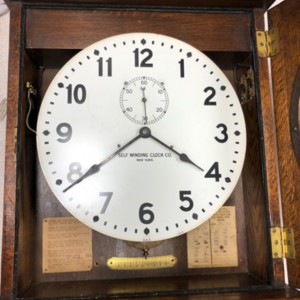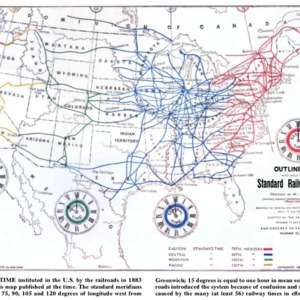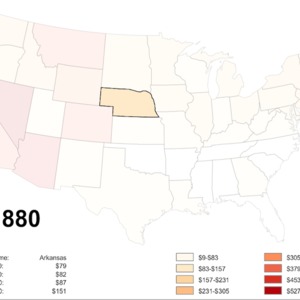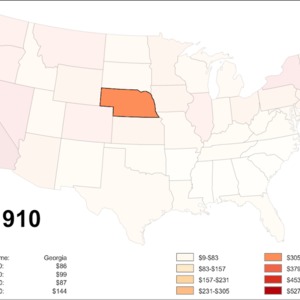Railroad Clock
Title
Subject
Description
At first glance it may not be clear exactly how a clock fits into the concept of the Anthropocene. This is not an ordinary clock, however. It is a Union Pacific standard time clock. This clock was used by Union Pacific Railroad to help keep trains running smoothly and efficiently in and out of Omaha, Nebraska. The standard clock reveals the role played by the railroad in Omaha’s urban development. The clock provided a standard measure for which time was to be set all over America, not solely in Omaha. It represented the industrial and commercial standardization of time and could be easily translated to the different time zones around America and around the world. The standardization of time allowed railroads and industries to run at peak efficiency and consume natural resources quicker. It also increased the negative environmental consequences of those activities. Time itself is a subject of fundamental interest in Anthropocene discourse. In a narrow, stratigraphical sense, the concept signifies a new division of geological time. The Union Pacific Railroad Clock demonstrates how the social construction of standard time reshaped humanity’s relationship with nature.
Our object, the Standard Clock, was created by the Self Winding Clock Company for use by Union Pacific Railroad. (Figure I, Figure II) It hung in the telegraph office of Omaha’s Union Station until the station closed in 1971. The clock served as the official clock by which workers would set their watches. Clocks like this would have enabled the train station to run at peak efficiency and allow for smooth movement of trains in and out of the station. Telling the history of standard time and the railroads in Omaha would not be complete without a discussion of Union Pacific.
Headquartered in Omaha, the Union Pacific was one of the largest railroad companies in America during the 19th century. It played a major role in the history of Omaha. In 1862, Thomas Durant, the first vice president and general manager of Union Pacific, persuaded President Abraham Lincoln to make Omaha the eastern terminus of the transcontinental railroad. The first rail of the track was laid on July 10, 1865 and would signal the beginning of Omaha’s urban history. After the passage of the Homestead Act in 1863, “settlers and immigrants poured into the area… and today this vibrant city has a population of nearly 500,000” (Union Pacific, 2018). Between the years 1880 and 1910 Nebraska’s per capita income increased from about $150 to a little over $300 (Figure III and IV). Omaha became a bustling railroad town, but like other cities, it kept its own local time.
Before standard time, railroad time used the local times of major cities. This was known as local solar time. For example, noon in Kansas City was just when the sun was over head. Local solar time was “a group of unrelated times...there was no ‘system’” (Bartky, 28). There was no way to coordinate all these times and make sense of them. As industry grew and more trains were on the rails this combination of local times was no longer safe or efficient. Railroad companies required a more accurate means of timekeeping. “Railroads were particularly interested in accurate timekeeping for the safe running of trains and for scheduling time tables. Slowly, a network of railroad regional times replaced a hodge podge of local times” (Levinson, 10). A growing consensus emerged among railroads companies that there needed to be a single time in order to increase safety and efficiency.
Local time was no longer something that was feasible. So, “on Nov. 18, 1883, the country's railroad magnates, acting on the theory that they needed provisional time zones to coordinate their train schedules” created Standard Railroad Time and in essence “seized control of the hands of time itself” (Feuer, 26). The railroads demonstrated the significance of time-related values regarding the speed and effectiveness of productivity. “In 1873, there were over seventy regional railroad times across the United States. By 1883, the railroad industry implemented a system of five distinct time zones in North America-Intercolonial (now Atlantic), Eastern, Central, Mountain, and Pacific” (Levinson, 13). (Figure V) Such concepts of time were seen not only in the United States but in other regions throughout the world. It would take a while for Standard Railroad Time to be adopted across America. In 1918, the New York Central Railroad petitioned Congress and the Standard Time Act was passed. This enacted into law railroads’ time zones as the standard way to measure time across America.
Like other industrial cities in America and abroad, Omaha would eventually come to adopt standard time and use clocks such as ours to keep time. Time keeping became a standardized process on the global scale. This global standard time would even come to impact Creighton University. Father Rigge kept two clocks in the observatory on campus in order to record the time with the utmost precision. In order to keep the time accurate “Western Union Telegraph Company sent the beats of the clock of the Naval Observatory in Washington, D.C., to our Observatory on every week day at 11 A.M., from January 1887 to about the end of 1894” (Rigge, 88). The advent of railroads and standard time was causing Omaha to become a more globally interlinked city than in previous years. Railroads had a hand in helping to redefine Omaha as a global city, connected via transportation networks to distant locations.
The influences of the railroad on urban industrialization was a global phenomenon. While the Union Pacific railroad allowed for the rapid industrialization of cities like Omaha, similar transformation took place in states around the world. In 1884, Greenwich Mean Time was adopted internationally. This standardization of time increased the efficiency of international business and commerce while creating a globalized interconnectivity between countries. Figure VI shows the rapid growth in China’s GDP over a period of five years. (Figure VI) While China’s growth in GDP can be attributed to several factors, this increase is due in part to the development of the railroad throughout the nation. Due to the development of railroads, China was able to conduct commerce with countries that were otherwise inaccessible, greatly increasing China’s GDP. China invested in railways, which provided an increase in their railroads represented by an acceleration of industry across the world. It “marked a decisive break with all previous history. They were faster than the fastest horse and carriage or the fastest dispatch rider...however different the cultural reactions and modes of employment, the effects of rail travel were in principle the same all over the world” (Osterhammel, 74). The time it took to transport raw materials and products was greatly reduced thanks to the introduction of a much quicker mode of transportation.
The adoption of Greenwich time across the world “increased the efficiency of international business” and “enabled administrative services to be co-ordinated too” (Ogle, 76). Asia was one such area where this effect was felt. From the years 1870-1911, China and Japan implemented the railroad at two very different rates. Japan implemented railroad technologies very rapidly and effectively. China resisted this movement due to backlash from more rural communities wanting to maintain traditional values. “The Meiji government justified the early adoption of railroad technology by appealing to the technology’s economic modernization effects” (Schmid, 571). The rapid innovation and implementation of the railroad within Japan created economic growth for the nation. At the same time, it allowed for increased modernization of urban settings. In China, the nation hesitated with investing in such technologies because “the Chinese leadership anticipated that the introduction of railroads would also have significant negative consequences” (Schmid, 572). While China was hesitant, Japan industrialized rapidly, showing the significance and impact of the railroad in the development of cities. By the early twentieth century, railroads were a global phenomenon and evidence of the spread of Western industrial power.
The standard time of railroads has had a clear impact throughout history, especially during the Second Industrial Revolution. While trains ceased to be the common mode of transportation in the 21st century the effects of this earlier period of history are still important to societies today. The connections established and solidified during the nineteenth century have expanded into the 21st century. One can scarcely imagine globalized interconnectivity and commerce without a standardized measure of time. The environmental impacts of globalization are diverse, but can be most directly observed in climate change.
One of the most prevalent areas where time is felt in today’s society is climate change. By the year 2000 the IPCC reported that “global average temperatures had risen...by about 0.8℃ since the beginning of the 20th century” and “there is little doubt that this is because of human activities” (Aldrich, 31). The most alarming part is the rate at which this change is taking place. It is having a major effect on our ecosystems. Earth’s ecosystems run on a biological clock. All living things have “biological timing, the timekeeping in living organisms, in plants, and in animals including people” (Binkley, 4). However, human effects on the environment have distorted the timing of nature’s biological clock. Over the last 50 years plants in the Royal Botanic Gardens have begun blooming six days earlier and “in western Canada the aspen is blooming 26 days earlier than a century ago” (Aldrich, 32). Animal wildlife is also being affected. Migratory birds are arriving north earlier and leaving later in the fall. The acceleration of industries via railroads has had a major impact on the biological timing of the environment.
The rise in industries has led to an increase in greenhouse gas emissions due to corporate activities. In the UK, supermarkets “may be responsible for up to 10% of emissions” (Sullivan and Gouldson, 733). However, companies are working to reduce this. Between “2000–2010, UK supermarkets invested significant resources in reducing their emissions through improving building and transport energy efficiency, reducing refrigerant losses and increasing the use of renewable energy” (Sullivan and Gouldson, 733). UK based supermarkets have already started seeing improved operational efficiency. These finding show that “larger companies have the potential to achieve long-term sustained reductions in emissions, but...achieving these benefits requires a continual focus on developing and testing new technologies” (Sullivan and Gouldson, 739). The Anthropocene is not a hopeless cause, there are many solutions being proposed to help reduce the negative impact of humans on the environment.
Another solution that has been discussed is increasing the presence and utilization of railroads within modern societies to lessen the carbon emissions contributing to climate change. It is somewhat ironic that the railroad, a major agent in the industrialization that created current climate issues, is now being utilized to combat such environmental issues. In terms of releasing carbon emission, the transportation industry is a large contributor. Implementing low-carbon emission innovations in the transportation industry will greatly cut the world’s carbon emissions. “The total CO2 emissions of highway freight transportation is 7.89-10.45 times more than that of railway freight transportation.” (Boliang, 97). To put this into perspective, if just 10% of highway freight was instead transported via railway, 22 million tons of carbon emissions would be prevented from entering the atmosphere (Boliang, 97). While the railroad has helped urbanize and industrialize both the United States and other global nations, it also provides an opportunity for resolving the modern issues of excessive carbon emissions.
Railroads and the adoption of standard time has had a major impact on Omaha’s local history, global history, and development of the Anthropocene. Union Pacific, an Omaha based company, connects Nebraska to the rest of America. The Union Pacific Standard Clock stewarded this industrial integration into the present and promoted the accelerated growth of industries all over the world. This growth has had harmful effects on our climate and environment but the story is not just a negative one. Railroads also provide a possible solution for the future.
Creator
Thomas Haggstrom
Source
"The Great Race to Promontory: The 150th Anniversary of Driving the Golden Spike." Accessed November 5, 2018. https://www.up.com/goldenspike/index.html.
Aldrich, Tim. About Time Speed, Society, People and the Environment, edited by Aldrich, Tim E., Will Hutton. Sheffield: Sheffield : Greenleaf Pub, 2005.
Bartky, Ian. "The Adoption of Standard Time." Technology and Culture 30, no. 1 (1989): 25.
Binkley, Sue. Biological Clocks: Your Owners Manual. Harwood Academic Publishers, 1997.
Boliang, Lin, Chang Liu, and Huijun Wang. "Modeling the Railway Network Design Problem: A Novel Approach to considering Carbon Emissions Reduction." Transportation Research Part D56 (2017): 95-109.
Levinson, Martin H. Time-Binding Time: A History of Time-Measurement and Time-Management in America, April 2014, 1-11.
Ogle, Vanessa. The Global Transformation of Time : 1870-1950 Cambridge, Massachusetts; London, England : Harvard University Press, 2015.
Osterhammel, Jürgen. The Transformation of the World : A Global History of the Nineteenth Century, edited by Camiller, Patrick Princeton : Princeton University Press, 2014.
Rigge, William F. Memoirs, edited by David E. Crawford, Stefanie Lierz February 1, 2008.
Schmid, Jon, and Jonathan Huang. "State Adoption of Transformative Technology: Early Railroad Adoption in China and Japan." International Studies Quarterly 61 (2017): 570-83.
Sullivan, Rory, and Gouldson, Andy. "Ten Years of Corporate Action on Climate Change: What Do We Have to Show for It?" Energy Policy 60 (2013): 733-40.
Rights
Collection
Citation
Embed
Copy the code below into your web page
